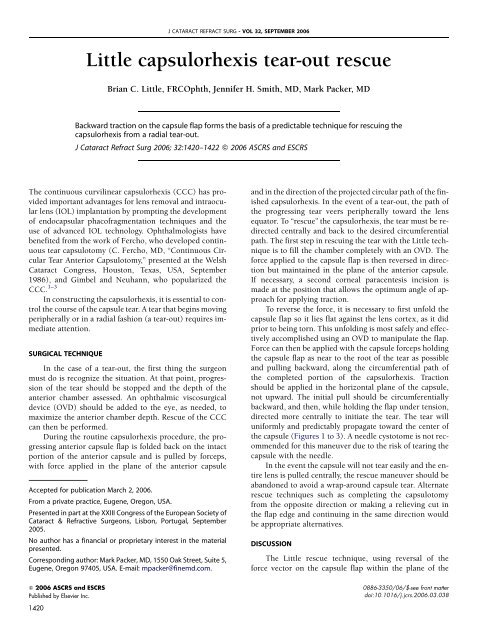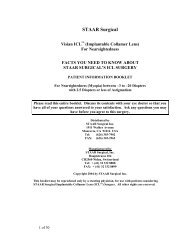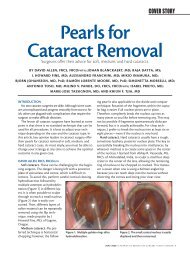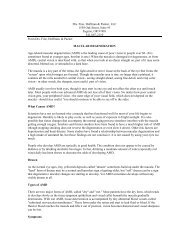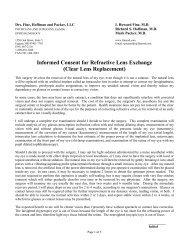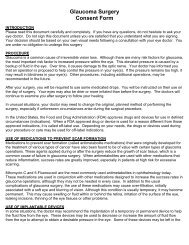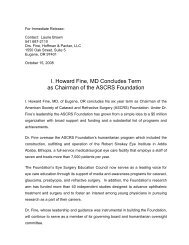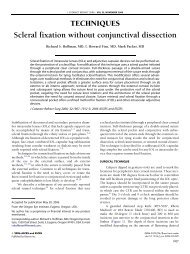Little capsulorhexis tear-out rescue
Little capsulorhexis tear-out rescue
Little capsulorhexis tear-out rescue
You also want an ePaper? Increase the reach of your titles
YUMPU automatically turns print PDFs into web optimized ePapers that Google loves.
<strong>Little</strong> <strong>capsulorhexis</strong> <strong>tear</strong>-<strong>out</strong> <strong>rescue</strong><br />
Brian C. <strong>Little</strong>, FRCOphth, Jennifer H. Smith, MD, Mark Packer, MD<br />
Backward traction on the capsule flap forms the basis of a predictable technique for rescuing the<br />
<strong>capsulorhexis</strong> from a radial <strong>tear</strong>-<strong>out</strong>.<br />
J Cataract Refract Surg 2006; 32:1420–1422 Q 2006 ASCRS and ESCRS<br />
The continuous curvilinear <strong>capsulorhexis</strong> (CCC) has provided<br />
important advantages for lens removal and intraocular<br />
lens (IOL) implantation by prompting the development<br />
of endocapsular phacofragmentation techniques and the<br />
use of advanced IOL technology. Ophthalmologists have<br />
benefited from the work of Fercho, who developed continuous<br />
<strong>tear</strong> capsulotomy (C. Fercho, MD, ‘‘Continuous Circular<br />
Tear Anterior Capsulotomy,’’ presented at the Welsh<br />
Cataract Congress, Houston, Texas, USA, September<br />
1986), and Gimbel and Neuhann, who popularized the<br />
CCC. 1–3<br />
In constructing the <strong>capsulorhexis</strong>, it is essential to control<br />
the course of the capsule <strong>tear</strong>. A <strong>tear</strong> that begins moving<br />
peripherally or in a radial fashion (a <strong>tear</strong>-<strong>out</strong>) requires immediate<br />
attention.<br />
SURGICAL TECHNIQUE<br />
In the case of a <strong>tear</strong>-<strong>out</strong>, the first thing the surgeon<br />
must do is recognize the situation. At that point, progression<br />
of the <strong>tear</strong> should be stopped and the depth of the<br />
anterior chamber assessed. An ophthalmic viscosurgical<br />
device (OVD) should be added to the eye, as needed, to<br />
maximize the anterior chamber depth. Rescue of the CCC<br />
can then be performed.<br />
During the r<strong>out</strong>ine <strong>capsulorhexis</strong> procedure, the progressing<br />
anterior capsule flap is folded back on the intact<br />
portion of the anterior capsule and is pulled by forceps,<br />
with force applied in the plane of the anterior capsule<br />
Accepted for publication March 2, 2006.<br />
From a private practice, Eugene, Oregon, USA.<br />
Presented in part at the XXIII Congress of the European Society of<br />
Cataract & Refractive Surgeons, Lisbon, Portugal, September<br />
2005.<br />
No author has a financial or proprietary interest in the material<br />
presented.<br />
Corresponding author: Mark Packer, MD, 1550 Oak Street, Suite 5,<br />
Eugene, Oregon 97405, USA. E-mail: mpacker@finemd.com.<br />
Q 2006 ASCRS and ESCRS<br />
Published by Elsevier Inc.<br />
1420<br />
J CATARACT REFRACT SURG - VOL 32, SEPTEMBER 2006<br />
and in the direction of the projected circular path of the finished<br />
<strong>capsulorhexis</strong>. In the event of a <strong>tear</strong>-<strong>out</strong>, the path of<br />
the progressing <strong>tear</strong> veers peripherally toward the lens<br />
equator. To ‘‘<strong>rescue</strong>’’ the <strong>capsulorhexis</strong>, the <strong>tear</strong> must be redirected<br />
centrally and back to the desired circumferential<br />
path. The first step in rescuing the <strong>tear</strong> with the <strong>Little</strong> technique<br />
is to fill the chamber completely with an OVD. The<br />
force applied to the capsule flap is then reversed in direction<br />
but maintained in the plane of the anterior capsule.<br />
If necessary, a second corneal paracentesis incision is<br />
made at the position that allows the optimum angle of approach<br />
for applying traction.<br />
To reverse the force, it is necessary to first unfold the<br />
capsule flap so it lies flat against the lens cortex, as it did<br />
prior to being torn. This unfolding is most safely and effectively<br />
accomplished using an OVD to manipulate the flap.<br />
Force can then be applied with the capsule forceps holding<br />
the capsule flap as near to the root of the <strong>tear</strong> as possible<br />
and pulling backward, along the circumferential path of<br />
the completed portion of the <strong>capsulorhexis</strong>. Traction<br />
should be applied in the horizontal plane of the capsule,<br />
not upward. The initial pull should be circumferentially<br />
backward, and then, while holding the flap under tension,<br />
directed more centrally to initiate the <strong>tear</strong>. The <strong>tear</strong> will<br />
uniformly and predictably propagate toward the center of<br />
the capsule (Figures 1 to 3). A needle cystotome is not recommended<br />
for this maneuver due to the risk of <strong>tear</strong>ing the<br />
capsule with the needle.<br />
In the event the capsule will not <strong>tear</strong> easily and the entire<br />
lens is pulled centrally, the <strong>rescue</strong> maneuver should be<br />
abandoned to avoid a wrap-around capsule <strong>tear</strong>. Alternate<br />
<strong>rescue</strong> techniques such as completing the capsulotomy<br />
from the opposite direction or making a relieving cut in<br />
the flap edge and continuing in the same direction would<br />
be appropriate alternatives.<br />
DISCUSSION<br />
The <strong>Little</strong> <strong>rescue</strong> technique, using reversal of the<br />
force vector on the capsule flap within the plane of the<br />
0886-3350/06/$-see front matter<br />
doi:10.1016/j.jcrs.2006.03.038
TECHNIQUES: CAPSULORHEXIS TEAR-OUT RESCUE<br />
Figure 1. The use of trypan blue stain highlights the<br />
basic steps of the technique. A: The flap is folded forward<br />
as the <strong>capsulorhexis</strong> is constructed. B: The flap<br />
is unfolded and grasped. C: The flap is pulled backward<br />
to redirect the <strong>tear</strong> centrally. D: The flap is refolded forward,<br />
and the <strong>tear</strong> is continued.<br />
Figure 2. Demonstration of the application of the technique<br />
with the <strong>capsulorhexis</strong> torn in the area of zonular<br />
attachments. A: The <strong>capsulorhexis</strong> has inadvertently<br />
torn into the zonules. B: The flap is unfolded, grasped,<br />
and pulled backward. C: Backward traction on the flap<br />
has redirected the <strong>tear</strong>. D: The <strong>capsulorhexis</strong> is continued<br />
in the standard fashion.<br />
J CATARACT REFRACT SURG - VOL 32, SEPTEMBER 2006 1421
capsule, results in consistent and effective central redirection<br />
of a capsule <strong>tear</strong>. Once the <strong>tear</strong> is <strong>rescue</strong>d, the<br />
capsule flap is folded back over the anterior lens surface<br />
and the <strong>capsulorhexis</strong> <strong>tear</strong> is continued in the r<strong>out</strong>ine<br />
fashion.<br />
As advancing IOL technology demands increasing<br />
technical precision in our phacoemulsification procedures,<br />
it becomes more important to identify reliable maneuvers<br />
for addressing intraoperative challenges. This technique<br />
for rescuing a CCC <strong>tear</strong>-<strong>out</strong> provides a simple and effective<br />
1422<br />
TECHNIQUES: CAPSULORHEXIS TEAR-OUT RESCUE<br />
method for dealing with this common and potentially<br />
difficult surgical occurrence.<br />
REFERENCES<br />
J CATARACT REFRACT SURG - VOL 32, SEPTEMBER 2006<br />
Figure 3. Demonstration of the use of a new paracentesis<br />
to obtain optimal positioning for redirecting the<br />
<strong>tear</strong>. A: The <strong>capsulorhexis</strong> is <strong>tear</strong>ing <strong>out</strong>. B: The forceps<br />
is removed from the eye and the <strong>tear</strong>-<strong>out</strong> examined. C:<br />
A new incision is made across from the position of the<br />
<strong>tear</strong>-<strong>out</strong>. D: The apex of the flap edge is grasped and<br />
pulled backward from the direction of the <strong>tear</strong>. E:<br />
The <strong>tear</strong> is redirected centrally. F: Demonstration of<br />
the <strong>capsulorhexis</strong> U-turn.<br />
1. Neuhann T. Theorie und Operationstechnik der Kapsulorhexis. Klin<br />
Monatsbl Augenheilkd 1987; 190:542–545<br />
2. Gimbel HV, Neuhann T. Development, advantages, and methods of the<br />
continuous circular <strong>capsulorhexis</strong> technique. J Cataract Refract Surg<br />
1990; 16:31–37<br />
3. Gimbel HV, Neuhann T. Continuous curvilinear <strong>capsulorhexis</strong> [letter].<br />
J Cataract Refract Surg 1991; 17:110–111


